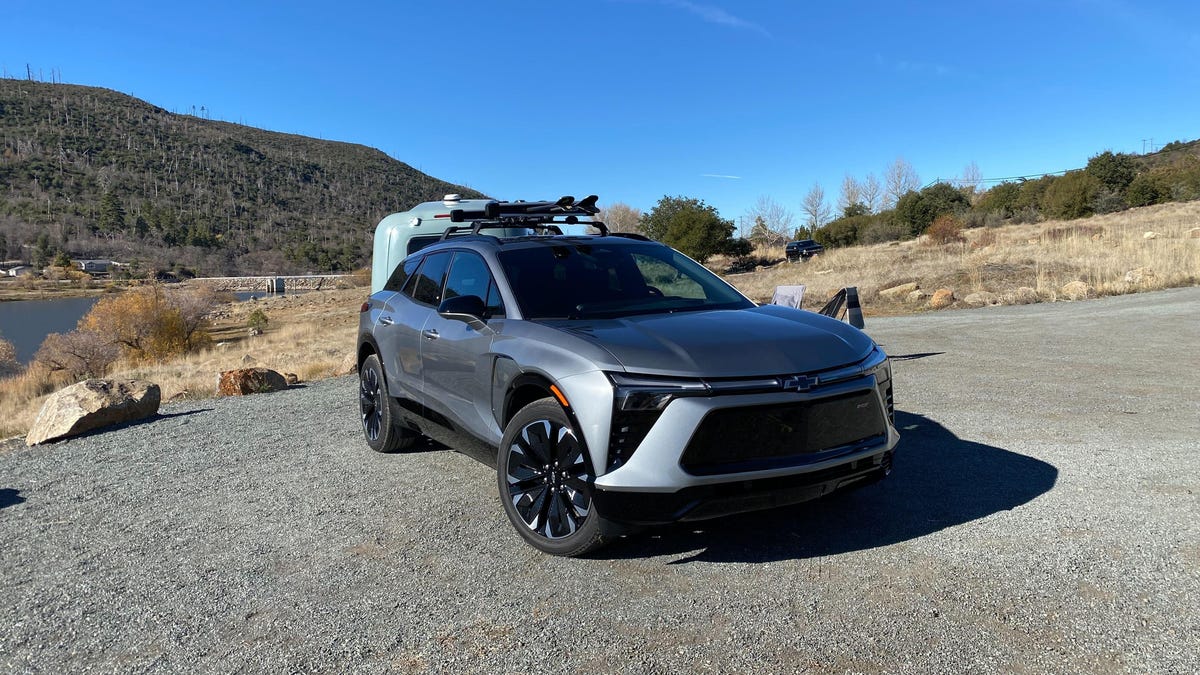Winding through the gorgeous scenery and twisty roads near Anza Borrego State Park near San Diego on the launch event for the new Chevrolet Blazer EV provided beautiful sights, even if the actual driving was a far from stimulating affair. But Chevrolet has achieved something that Polestar and Tesla and have not with the new Blazer EV; An EV that doesn’t feel like an EV.
From the driver’s seat, the Blazer offers a roomy and well-designed interior, with sufficient seat comfort, noise levels, and power. Those who hoped that the Blazer EV in RS trim was in any way sporty will be disappointed since neither the RWD nor the eAWD configurations encouraged me to brake later or push the limits of grip or even smile. Neither had the obligatory neck-snapping acceleration, the obligatory motorized (ruined) door handles, or the conceptually rethought (ruined) interior that is expected in a modern EV. The Blazer EV’s best party trick is being an incredibly normal EV meant for every Tom, Dick and Harry.
(Full disclosure: Chevy pampered me on my first-ever drive program and invited me down to the pristine beach town of Del Mar for two days to drive the new Blazer EV RS eAWD. I think it’s going to be a great car for a lot of people who are looking to spend around $50k on a sensible family crossover with jazzy styling.)
Chevy seems to be targeting customers who are curious about electric cars but might not be ready to dive head first into an entirely new vehicular ecosystem the way Teslas and many other EVs require. The key? Normal. The door handles? Traditional. The looks? Sharp but still conventional with a big fake grille to keep the normies happy. The driving experience? Very normal. So what’s the appeal? The appeal is that the Blazer is a very traditional midsize SUV, which just happens to be electric.
What is it?
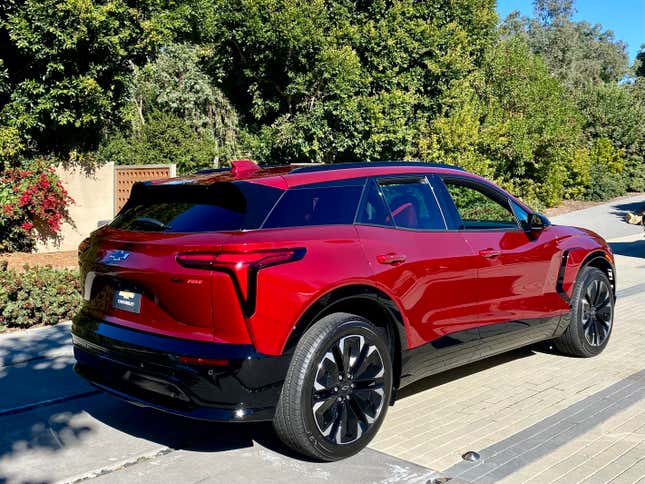
The Blazer EV is Chevy’s midsize two-row electric SUV offering built on GM’s Ultium platform shared with several other models. Blazer enters a contentious segment and faces off against a crowd of formidable competitors including the Ford Mustang Mach E, Hyundai Ioniq 5, Nissan Arya, Kia EV6, Volkswagen ID.4 and Tesla Model Y.
The Blazer EV is the first passenger vehicle, not a van, that will be available with FWD, AWD, or RWD configurations since the very specialized and never-sold-in-the-U.S. Renault Clio lineup. This seems like a very strange choice made by GM, but the engineering team told me it was so the Blazer would appeal to as many customers as possible. I had a quick drive in a RWD Blazer EV RS and spent several hours in the Blazer EV RS eAWD– no FWD models were available at the time of the launch event.
The Blazing:
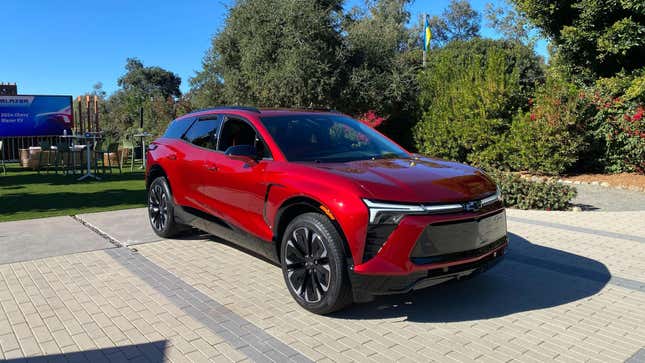
The first time I saw the Blazer EV I was immediately impressed by the looks. I love a long wheelbase on a car as it minimizes front and rear overhangs and keeps a car looking taught and athletic. Blazer has a very long wheelbase that’s actually an inch longer than Chevy’s own Tahoe despite Tahoe being 18.5-inches longer overall.
Aside from the long wheelbase, Blazer RS has some aggressive styling touches that make it look athletic and lean. The nose of the car is very upright yet curvaceous. Combined with the steep angle of the windshield, the Blazer looks like it’s ready to pounce. The design ethos of the entire vehicle lends itself to a muscular and futuristic look that sets it apart from the electrified competition, which generally take on a more blobby, amorphous shape.
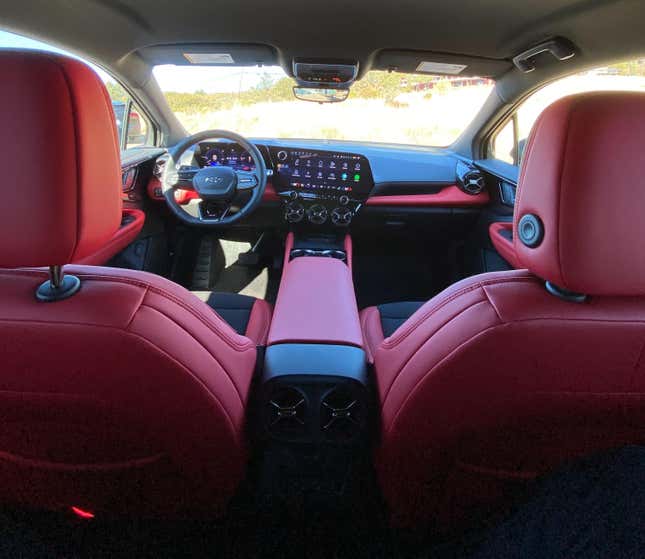
The interior of the Blazer is very conventional, with a row of buttons complimenting the giant 17.7-inch infotainment display and making the interface more traditional. The buttons exclusively control the climate functions, but there is a volume knob at the top left on the screen, too. No tuning knob for the stereo, but some physical controls are better than none.
The interior is spacious too, allowing my giant 6’8” tall frame to find comfortable driving positions and comfortable-enough space in the back seat behind a slightly shorter driver. The floor in the rear of the Blazer is higher than the front, causing it to feel a bit like you’re sitting in the fetal position despite being belted into the back seat of a family car.
Driving the Blazer EV was easy since it is so conventional. As long as the vehicle is already set to your preferences, you just hop in, tap the brake and pull the column shifter down for drive and you’re good to go.
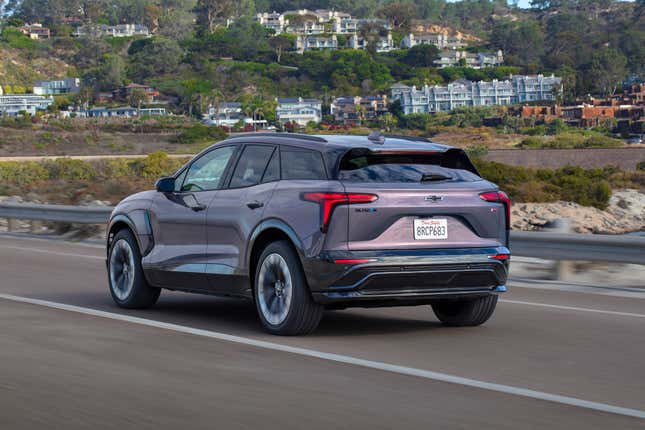
Blazer EV RS eAWD predominantly features FWD operation, but when slip is detected the rear motor engages to help with traction. The dual-motor configuration is rated at 288 combined horsepower and 333 combined lb-ft of torque. This configuration should get the Blazer EV from 0-60 in about 6-seconds, it weighs around 5200 pounds, and can tow up-to 1,500 pounds.
Power is decent, and it never snaps your neck like some of the Blazer’s segment competitors. Handling is sufficient, and driving the Blazer really feels like driving an ICE car. The automated driver’s assistance systems worked fine on my quick drive, with intuitive, conventional steering wheel controls.
The RWD Blazer will wear the crown of longest potential range in the lineup, estimated to achieve 320-miles on a charge. The eAWD Blazer RS that I drove is EPA rated for a maximum range of 279-miles on a charge. These range estimates are sufficient and very competitive in the segment, and on my drive the estimates seemed pretty attainable, especially with brake regen on.
One pedal driving in the Blazer EV takes a little getting used to, but after a few blocks you’ll be cruising like a pro. The Blazer EV only has three regeneration levels, off, normal, and high. The difference between normal and high regen is not very noticeable– the car will come to a complete stop in both modes, and the regen is intense in both modes. The regen modes are only adjustable through the 17.7-inch touchscreen, however, which becomes a hassle when you’re trying to adjust it on the move.
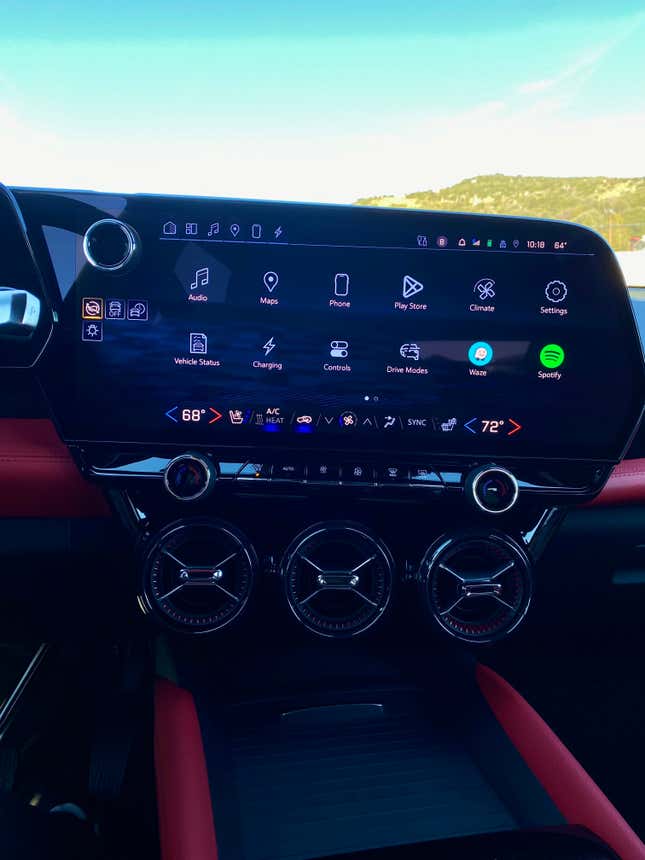
The Blazer does not come equipped with Apple CarPlay or Android Auto, though GM has worked hard to convince customers that they don’t need these much-loved interfaces. Chevy’s new infotainment system integrates applications that would normally be accessed via CarPlay, including Google Maps and Spotify. Users can use the Google Assistant to ask their Blazer to perform tasks, and the cars integrated 5G antenna should allow better signal for the onboard Google Maps. Google Maps will plan routes around charging stations and estimated range to streamline the experience of long-distance travel. Chevy offers eight-years of free 5G and Google Maps access with the Blazer. After those eight years, Chevy said it will shift to a monthly subscription fee.
The Not-So Blazing
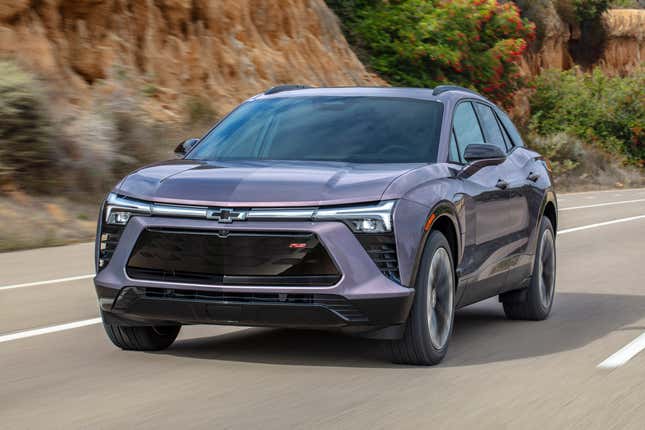
Despite GM’s best efforts to convince users that they don’t need Apple CarPlay or Android Auto, most of the non-car-people I know will not even consider owning a car without these features. In fact, most tell me that they don’t care what they drive as long as it has CarPlay. This omission will not be a selling point for Chevy, but its Google Maps and Spotify integrations are not bad alternatives.
The interior quality in the Blazer is disappointing for the price. The Blazer EV RS eAWD has a base MSRP of $57,595 before tax, title, license, dealer fees and optional equipment. Realistically, the price will be above $60,000 and despite looking good, I noted many interior materials that felt cheaper than the materials in my 2017 Mini Cooper.
While most of the common touch-points are acceptably padded and damped, should you try to put your water bottle in the door bin, it won’t fit and you’ll liberate your knuckles of all that pesky skin because the plastics are so abrasive. Aside from the cheap plastics, the panoramic sunroof on the RWD model that I drove rattled over every pavement imperfection. The eAWD models we drove for the longer stint were not fitted with the panoramic sunroof. The front seats are wide and flat, meaning there is minimal support to keep you in place when driving hard, and you feel like you’re sitting on top of the vehicle rather than inside of it despite the low center of gravity.
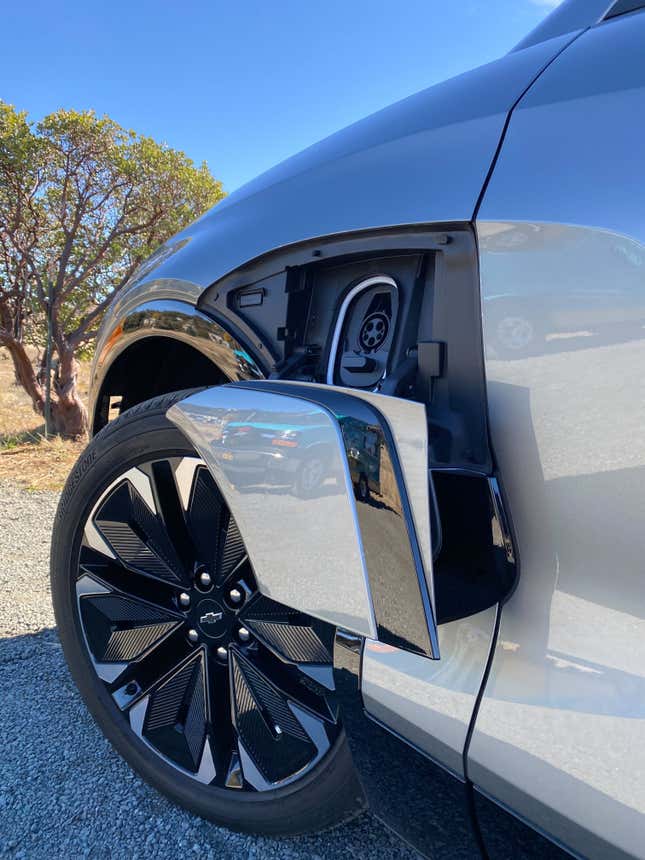
The Blazer EV, regardless of drivetrain configuration, does not have a frunk. This is a symptom that plagues EVs that are built by manufacturers who are not comfortable starting their EV platforms from a blank slate. The Blazer makes up for this with a rear cargo area that’s sizable, the rear seats fold flat, and there is a bit of underfloor storage, too.
Driving the Blazer is not going to light your hair on fire. As mentioned previously, the Blazer EV does not hit you with the same fierce acceleration as competitors like the Tesla Model Y and Mustang Mach E, but depending on your persuasion that might be a good thing. For me, it contributed to a dull driving experience. This is a big, heavy vehicle that never feels light or agile. Chevy had us drive some gorgeous scenic winding mountain roads and the Blazer felt massive on a two-lane roadway, mostly in width and weight. Quick steering inputs are mostly ignored by the Blazer, and it is quick to understeer. I noticed this driving characteristic in both the RWD and eAWD models, unfortunately.
The Blazer only offers a few selectable drive modes, and these modes have to be selected through the central touchscreen making it difficult to do while driving. Tour is the normal mode that’s automatically selected at start up. Sport mode slightly sharpens throttle response and adds weight to the steering, but I never noticed anything major. There’s a drive mode for slippery conditions, and there is“My Mode” that is customizable by the user and only allows custom choices between sport and normal which is disappointing. Brake regeneration is solid once you adjust to the aggressive deceleration that is achieved in both normal and high regen modes, but I wish there were more choices between normal regen mode which is already pretty aggressive and high regen which will throw passengers forward if you release the throttle. Additionally, these modes are only selectable through the touchscreen, forcing the driver to look away from the road to adjust brake regen.
Road noise while driving is not horrible, and primarily permeates the cabin by way of the big tires and wind noise from the wing mirrors and door handles. Given the price of the Blazer EV RS, it should be quieter, like the Cadillac Lyriq.
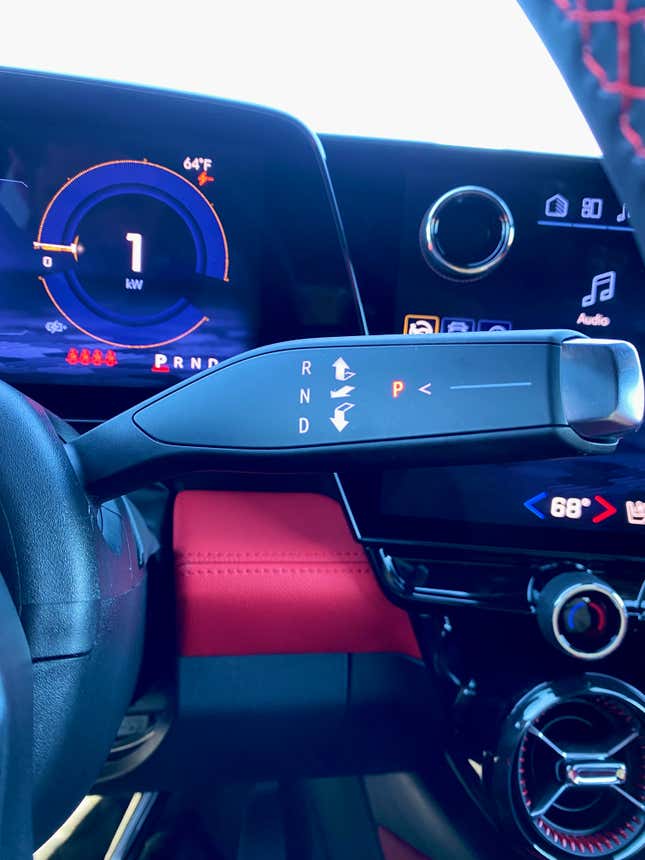
Operating the column-mounted shifter was unpleasant– it felt like a Bop-It that was about to break. Akin to the Mercedes-Benz column shifter but somehow much worse, the Blazer’s shifter requires drivers to pull the stalk toward them and then push down for drive or up for reverse. Seems simple, but trying to do a quick shift into reverse when cars are waiting for you ends in frustration and fear that you’ll snap the whole lever off the car.
Conclusion
The Blazer EV is one of very few vehicles that will qualify for the full $7,500 tax rebate in the new year, which bodes well for its success. The fact that Blazer EV is priced so similarly to the Cadillac Lyriq with which it shares a platform and which is also eligible for the full government rebate, makes it a bit of a hard sell.
If you think a Blazer RS is going to be a sporty experience, you are wrong. But if you think a Blazer RS will be a great family car, then you are right. The Blazer is not groundbreaking, and it does not need to be. I think the Blazer EV is a fabulously agreeable EV that may well be what the market needs. If only it was half the price….

